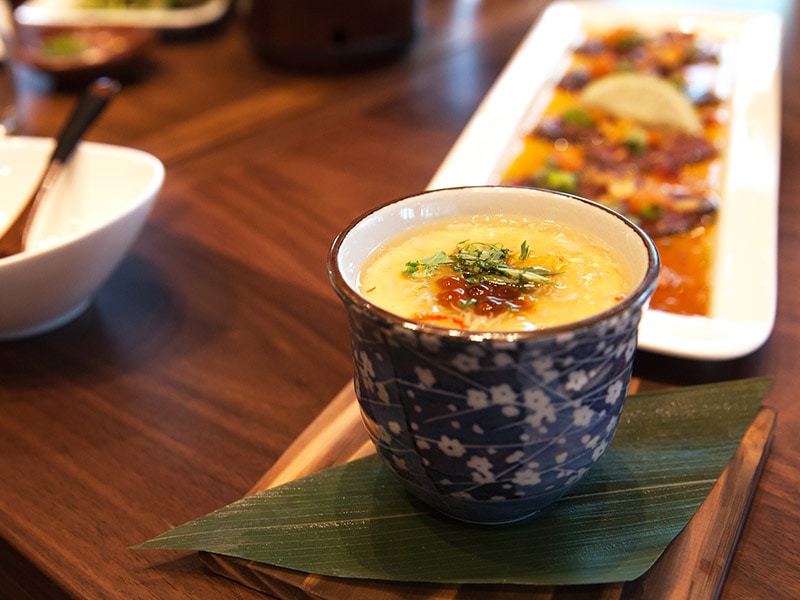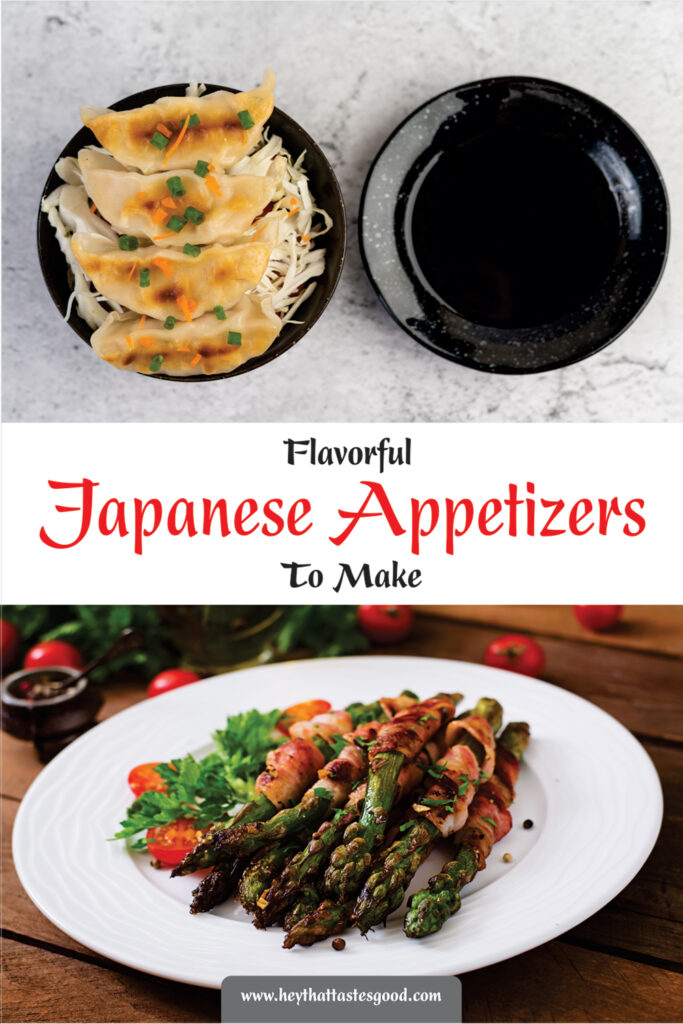At the beginning of a meal, Japanese appetizers, or Sakizuki, are served with Shokuzen-shu, a small glass of alcohol. This type of dish is meant to stimulate your appetite before the main course, which should be delicious but not heavy for the stomach.
If you have tested your cooking talent with numerous Japanese dishes for main courses, I think it’s a must to take on the challenge with a starter dish. Get ready, grab your spatula, and come with me on a journey of these finger-licking dishes.

Keep These Master Recipes Up Your Sleeve
Whether you are having guests over for a treat or preparing a fancy meal for yourself to shake up the week with outstanding Japanese cuisine, these recipes will help you create an astonishing opening to the feast.
Looking for veggies, seafood, or meat appetizers? Regardless, you’ll find what you need here.
1. Vegetable Gyoza (Japanese Vegetable Dumplings)
Total time: About 30 minutes
Sakizuke is defined as bite-size dishes served at the beginning of a meal, and Gyoza seems to be a perfect example of this.
These Japanese dumplings are great for starting a meal because they are so small yet delicious that they can awaken your appetite and prepare you for a feast.
Using store-bought wrappers makes the recipe much simpler and saves you a lot of time. Making the vegan filling should be a piece of cake. All in all, you will spend half an hour or so on these bite-size dumplings.
Depending on your guests’ preferences, you can boil, steam, or pan fry Gyoza. Each way of cooking gives the dumplings a different mouthfeel.
Wonder how to fold the wrappers of your dumplings? Find out here!
2. Sweet And Spicy Soy Glazed Edamame
Total time: 10 minutes
Sweet and spicy glazed edamame is a very popular dish in Japan in particular and in Asia in general.
Eating edamame to start a meal is reasonable because it’s a “light” ingredient, meaning it won’t make you full quickly like meat or rice. True to its name, this dish comes with a combination of flavors, including sweet, spicy, and umami tastes.
This dish is also very easy to make. First, all the ingredients can be found easily in supermarkets. Second, the steps are extremely simple.
All you have to do is cook the edamame, mix all the wet ingredients, cook the mixture, and then mix with the cooked edamame so that the sauce is distributed evenly.
3. Hiyayakko (Japanese Chilled Tofu)
Total time: 5 minutes
Hiyayakko is a signature cold appetizer with tofu cut into cubes served with toppings. The toppings used in this dish include scallions, ginger, and bonito flakes.
It’s complete with a few signature sauces and condiments of Japan, including soy sauce and ponzu sauce that you can easily find in any supermarket.
Note that you can’t use any type of tofu to make Hiyayakko. It has to be extra soft tofu or the type with a silken texture. It’s best to buy tofu at a Japanese grocery store as you will find the right type quicker.
To make Hiyayakko, dice the tofu into cubes, place them on separate plates or bowls, then add topping and finish with the sauce. Remember to let the tofu drain beforehand for at least 15 minutes.
See what silken tofu looks like to buy the right tofu for your dish.
4. Shoyuzuke Kyuri (Japanese Pickled Cucumbers with Soy Sauce)
Total time: 8 hours and 15 minutes
In traditional Japanese cuisine, Tsukemono is pickles served with rice. You can use various native Japanese fruits or vegetables for this method. Shoyuzuke Kyuri, or Japanese pickled cucumbers, is a type of Tsukemono.
With soy sauce as the condiment, Shoyuzuke Kyuri features a miso flavor, salty taste, and certain crispiness.
Preparing this dish should take only 15 minutes, which involves chopping cucumber and cooking a mixture of soy sauce, water, vinegar, and sugar. After that, the last step is marinating the cucumber in the cooked sauce for eight hours.
5. Harumaki (Japanese Spring Rolls with Pork)
Total time: 55 minutes
Harumaki is one of the examples showing how different Japanese cuisine is from Chinese one. Its fillings made of pork, mushrooms, and bamboo shoots have a gravy texture rather than dryness in Chinese spring rolls.
Harumaki is crunchy on the outside and tender, a little chewy on the inside. This contrast in texture makes Harumaki an interesting appetizer and side dish in Japanese cuisine.
When making Harumaki, you may want to keep these tips in mind. The first tip is to make sure the filling is at room temperature or chilled before wrapping. Otherwise, the spring rolls may explode when fried.
Plus, after frying the rolls for a little and they’re about to turn brown, raise the temperature a little. This tip will help prevent the rolls from getting greasy.
6. Japanese Izakaya Style Salted Cabbage
Total time: 5 minutes
This bite-sized appetizer and side dish is originally made with only salt, sesame oil, and pepper. But this recipe adds more taste to the dish, creating a complete umami flavor to stimulate your appetite.
For those who don’t know about the Izakaya style, this word refers to places in Japan where people come to have food and drink with friends or business associates. At Izakaya, people munch and drink together with small plates of food.
So, when talking about an Izakaya-style dish, we are food for munching served in small plates, like this salted cabbage.
It’s worth noting that this recipe doesn’t involve any cooking, which means the cabbage is served raw. Therefore, make sure you wash it carefully to ensure hygiene.
You can also make Otsumami with soba soup. See how to adjust the recipe.
7. Daikon Fukumeni (Simmered Daikon)
Total time: 1.5 hours
Daikon alone has a mild taste, but cooking at a high temperature helps bring out its slightly sweet flavor. With dashi used as broth, and mirin and soy sauce used as condiments, the resulting dish has a slightly salty, peppery flavor.
This cooking method also explains the “Fukumeni” word in the recipe name, which literally means cooking in a lightly flavored broth.
After chopping the daikon, you need to round the pieces’ edges. On the one hand, it helps make them look nicer; on the other hand, it prevents the edge from breaking off, which would otherwise happen if you don’t round them.
8. Tsukune (Japanese Chicken Meatballs)
Total time: 40 minutes
If there’s one thing that can activate your food mood, Tsukune must be it. These delicious meatballs are made of ground chicken, seasoned with cooking alcohol, garlic, ginger, mirin, soy sauce, sesame oil, and sugar.
When it comes to starters using chicken, you’ll often meet Tsukune served with beer at Izakayas. You can grill or pan-fry Tsukune. Either way, you will get crispy yet tender chicken meatballs that taste a little salty and sweet, paired with the signature smell of the sauce.
Instead of round meatballs, you can make any shape like this recipe.
9. Sunomono (Japanese Cucumber Salad)
Total time: 15 minutes
Salad is always the first thing that comes to mind when one talks about appetizers. It is the ultimate dish to start a meal, and it never fails.
Among various salad dishes in Japanese cuisine, Sonomono may be the simplest ever, involving only six ingredients and four steps from start to end.
In Japanese, Sunomono means food soaked in vinegar. There are many versions of this dish as the dish can be made with any type of greens. However, cucumber is the most popular ingredient used in Sunomono.
It can make a great start to a meal or a yummy side dish to add a slightly sweet, tangy, refreshing flavor to other dishes served to you.
10. Gobo Salad
Total time: 15 minutes
In Japan, Gobo is the word for burdock roots, a common type of vegetable in this country. Gobo is hard, looks like tree roots, turns soft when cooked and has an earthy flavor often found in root vegetables.
Apart from Gobo, this appetizer (or side dish) also has carrots. You need to thinly slice both these ingredients, cook them briefly in boiling water, let them cool, and then mix them with spices and condiments. The last step is sprinkling sesame seeds on top.
Note that you should only do the mixing step right before serving, not long beforehand. Otherwise, more juice will come out of Gobo and carrots, making the salad wet and ruining the texture.
11. Misoshiru (Miso Soup)
Total time: 20 minutes
Mishoshiru or Miso soup is the perfect starter for a cold-day meal. It warms you up, helps you stop shivering, and gets you ready for a nice dinner. Consisting of only vegetables and tofu, this dish doesn’t require much effort or sophisticated preparation techniques.
So, you can relax, follow this recipe step by step, and after 20 minutes, you can enjoy a bowl of tasty hot soup before getting to the main course.
Also, while the recipe I introduced to you used white miso, feel free to use red miso if that’s what you have ready in the kitchen.
12. Chawan Mushi (Japanese Steamed Egg Custard)
Total time: 25 minutes
Are there any Japanese recipes for making egg as an appetizer? Yes, of course.
Chawan means “teacup”, and Mushi means “steam”. Combining these words, we have Chawan Mushi, a steamed egg custard served in a teacup, which is found in Japan. If some days you don’t want soup to begin a meal, try this dish.
A serving of Chawan Mushi contains several main ingredients, namely egg, shrimp, mushroom, chicken breast, and carrot or white radish per choice.
Traditionally, this dish comes in small cups with lids. If these containers are not available in your house, you can use ramekins or any type of small cups instead.
If you want to keep it simple, you can make the dish with eggs only.
13. Vegetable Tempura (Battered Vegetable Fried)
Total time: 25 minutes
Tempura is a Japanese dish where meat, seafood, or vegetables are battered and deep-fried. For the sake of the appetizer, you should use vegetables rather than meat or seafood because you don’t want to fill your guests’ stomachs right at the beginning of the meal.
Especially if there are children, you can use this vegetarian dish from Japan to get them to eat some greens. They may be willing to eat something as crunchy as a snack.
Almost any type of vegetables can be made with this recipe, but it’s best to go for the types you can chop into bite-size pieces. These are easier to batter and fry.
14. Agedashi Tofu (Fried Tofu In Dashi)
Total time: 15 minutes
If you are looking for ways to cook tofu in Japan, Agedashi Tofu can make an elegant starter for your meal. Its name says all about how it’s made: fried tofu in dashi.
Agedashi tofu consists of tofu blocks coated with potato starch, fried, and served in dashi broth.
Though making Agedashi tofu takes about 15 minutes, it does require extra time to drain the tofu before frying. This is to avoid the mess of water and oil splattering everywhere when you fry tofu.
One essential factor that determines the taste of this dish is what type of tofu you choose. There are firm tofu and soft tofu (or silken tofu) with different production methods and textures.
Firm tofu is chunky, harder, and you can bite and chew them like regular food. Meanwhile, soft tofu easily breaks if you don’t handle it carefully; it sort of melts in your mouth and you don’t have to chew it.
15. Japanese Potato Salad
Total time: 25 minutes
Potato salad is very common among Japanese households due to how easy it is to make. It’s safe to say anyone can create a good plate of Japanese potato salad.
Other than potatoes, you will have to prepare other ingredients, such as Djon mustard – a type of mustard made from white wine and brown mustard seeds. There’s also pepper, Mayonnaise, salt, and rice vinegar.
One thing I want you to note down is that you should avoid serving much of this dish before the main course. Potatoes are rich in starch, so your guests will feel full quickly if they consume a lot of potato salad.
Apart from potatoes, you can also add carrot, cucumber, and some ham to the salad.
16. Nasu Dengaku (Japanese Miso Eggplant)
Total time: 20 minutes
Nasu Dengaku, or Japanese miso eggplant, can be used as a side dish or an appetizer. It has a bit of a smoky flavor, sweet and salty.
This dish is not difficult at all, and it uses all the common ingredients that can be found in any supermarket. However, you can be flexible with the amount of each spice because not all eggplants come in the same size.
If you happen to buy an eggplant larger than usual, consider increasing the amount and vice versa. Also, keep in mind that you are using this dish to prepare your guests for main dishes, so you don’t want its flavor to be so strong that it undermines the dishes following it.
17. Okura Ohitashi (Japanese Okra Salad)
Total time: 15 minutes
Ohitashi is a cooking method in Japanese cuisine, which means soaking. Okura Ohitashi is a Japanese dish where okra is blanched, then soaked in a mixture of mirin, alcohol, dashi, and soy sauce cooked in a saucepan.
This finished dish features an umami flavor from dashi, a savory flavor from soy sauce, and sweetness from mirin.
To avoid overcooking the okra, you should put it in an ice bath right after blanching. Also, you should squeeze water out of the okra so it can absorb the marinade well, ensuring the best taste for the appetizer.
18. Tenderloin Rumaki (Japanese Tenderloin Wrapped In Bacon Strips)
Total time: 30 minutes
Originating in Japan, Rumaki has become a popular meal-starter since the 1960s and 1970s. Originally, Rumaki was bacon strips wrapped around water chestnuts and chicken liver marinated in soy sauce.
In this specific recipe, however, Tenderloin Rumaki consists of beef chunks and scallion wrapped in bacon strips. You need to put them in a pan, transfer them to the oven to cook then pour the sauce on top.
After half an hour or so, you will get the result with a little crispy bacon and tender, juicy medium-rare beef.
19. Ebi Fry (Japanese Fried Shrimp)
Total time: 40 minutes
What do you think about making shrimp into a flavorsome appetizer? If you are having a seafood feast for your guests, starting with Ebi fry or Japanese shrimp fried is a good idea.
Ebi fry, a Japanese appetizer, is made by breading shrimps, frying them, and serving them with Katsu sauce. Katsu sauce is another name for Tonkatsu sauce, a combination of soy sauce, Worcestershire sauce, sugar, and other ingredients.
Generally, shrimps have a tougher texture than meat. This is paired with the crispy texture of the bread crumb outer layer. Dipping the fried breaded shrimp in the sauce, your appetite will be awakened and simulated for the coming party.
For those who don’t have enough ingredients and spices, you can follow this simple recipe.
20. Asparagus Rolls With Pork
Total time: 20 minutes
One of the best ways to begin a meal with asparagus is by rolling it with pork. In this recipe, you won’t use bacon; you will use thinly sliced pork.
What you need to do is roll the pork slices to fully wrap the asparagus, fry them at a medium temperature and add the sauce that you made following the recipe. You should consider using two asparagus sticks for each roll because they are normally thin.
This dish is best served hot. If the weather is cold or you don’t know when your meal starts, you can fry the rolls first, then reheat and add the flavoring sauce right before serving.
You Can’t Fail With Japanese Appetizers
While Japanese cuisine makes many people think its dishes are too hard to make and refuse to take the risk, it turns out these recipes are not that complicated. You’ll be fine as long as you follow the instructions closely and keep my notes in mind.
I hope the recipes introduced to you in this post will help you feel more confident on the path to conquering Japanese food. If you are happy with these dishes and successfully create amazing meals with the information you got from this article, make sure your friends and family can access these recipes as well.
Nutrition Facts
4 servings per container
- Amount Per ServingCalories62
- % Daily Value *
- Total Fat
2.3g
4%
- Saturated Fat 0.4g 0%
- Cholesterol 1mg 1%
- Sodium 484mg 21%
- Potassium 203mg 6%
- Total Carbohydrate
3.2g
1%
- Dietary Fiber 0.3g 0%
- Sugars 1.3g
- Protein 7g 15%
- Calcium 31%
- Iron 1%
* The % Daily Value tells you how much a nutrient in a serving of food contributes to a daily diet. 2,000 calories a day is used for general nutrition advice.




Linda Dean
Expertise
Culinary Arts, Food Journalism, Global Cuisine, Exploration, Recipe Development, Cultural Food Studies, Culinary Travel and Storytelling
Education
Culinary Institute of America, Hyde Park, NY
Program: Associate in Culinary Arts
Focus: Developed a comprehensive understanding of global cuisines and essential cooking techniques. Engaged in intensive hands-on practice in both kitchens and real-world settings, guided by expert chefs. This program emphasized the application of culinary skills in professional environments, preparing students for a variety of roles in the culinary industry.
City, University of London, London, UK
Program: BA Journalism
Focus: Gained expertise in media studies with a strong foundation in reporting, editing, and communicating. While the program focuses broadly on journalism, the skills acquired apply to food journalism, including the ability to analyze and report on food culture and culinary trends effectively.
Linda Dean is an experienced chef and food writer who loves exploring flavors from around the world. Trained at the Culinary Institute of America, Linda has spent over ten years mastering the art of making dishes that truly represent different cultures. She also studied journalism at City, University of London, which helps her write engaging stories about these foods.
On heythattastesgood.com, Linda shares recipes that bring the world’s kitchens to her readers. She focuses on authentic tastes and the stories behind them, making it easy for anyone to try international cuisine at home.